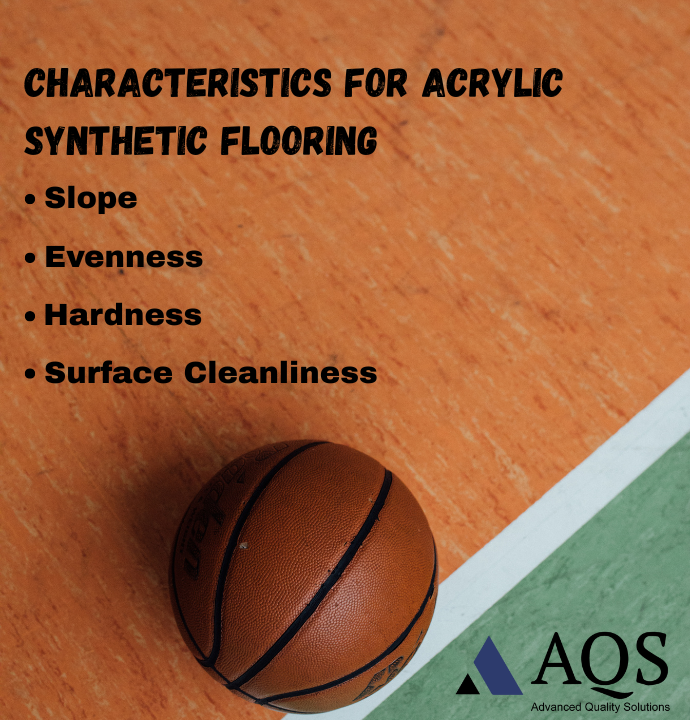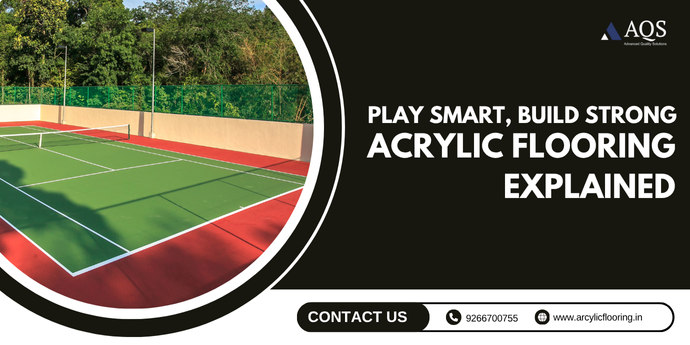When building an outdoor sports court, one of the most important aspects is the base preparation. The best base for sports flooring is the foundation of safety, durability, performance and longevity. A well prepared base means your surface will be stable, smooth and weatherproof for years to come, whether you’re building a tennis court, basketball court or multipurpose recreational area.
For a durable and high performing sports floor base, reinforced concrete (RCC) or asphalt/bitumen are generally the best options depending on the facility requirements. RCC provides a strong and stable foundation while asphalt/bitumen offers flexibility and can be more cost effective especially for outdoor courts.
At AQS (Advanced Quality Solutions) we understand the science and strategy behind base construction for acrylic synthetic flooring systems. This blog will guide the critical factors, base types, materials, installation tips and why your base determines the success of your sports surface.
Why the Base Is Key for Outdoor Sports Flooring
In any outdoor sports flooring system—especially acrylic synthetic courts, the base is very important. It forms the load-bearing foundation that supports the entire structure above. A properly designed and constructed base doesn’t just ensure the longevity of the court but also directly impacts athlete safety, game performance and long-term maintenance.
Here’s why the base is important:
- Shock Absorption and Player Safety
A high-quality base layer helps distribute impact forces evenly across the surface. This reduces stress on athletes’ joints, knees and ankles.
Benefit: Less fatigue and injury during high-impact sports like basketball, tennis and volleyball.
- Surface Evenness and Ball Bounce
The base determines how level and smooth the top playing surface will be. Any imperfections or unevenness in the base will show through the final surface layer, affecting both appearance and functionality.
Benefit: Consistent ball bounce and secure footing, essential for fair play and player confidence.
- Water Drainage
A properly sloped and graded base allows water to drain. This prevents water pooling on the surface which could lead to:
- Slippery and unsafe conditions
- Algae or moss growth
- Long term material damage
Benefit: All weather playability and reduced maintenance. The surface feel players experience is determined by the base stability. A solid, compacted base prevents flexing or movement under pressure which could otherwise affect traction.
- Crack Resistance and Durability
Many surface cracks and undulations come from poor base construction. A well built base minimizes movement from soil settlement or temperature changes.
Benefit: Fewer repairs, lower long term maintenance costs and longer court life.
Common Bases Used in Sports Flooring
Choosing the right base is key to the durability, performance and longevity of any sports flooring system. It depends on location, weather, drainage requirements and topcoat (like acrylic synthetic flooring). Below are the most common bases used in sports flooring construction:
Asphalt Base
Asphalt base is used in medium budget projects and suitable for areas with moderate climate. It’s a balance between performance and cost. Asphalt is flexible and can absorb some degree of ground movement without cracking and can be repaired if damage occurs.
But note that asphalt softens in high temperatures and can affect surface stability. To ensure long term performance, proper compaction and use of sealants are important. Not as durable as concrete but asphalt is a good option for many outdoor sports courts.
Concrete Base
Concrete is the preferred choice for high performance and long term sports flooring installations. It provides a solid, stable and extremely durable foundation, ideal for acrylic synthetic courts. When laid with the correct slope, concrete also has excellent water drainage capabilities and prevents surface water accumulation.
The disadvantage is that concrete can crack due to temperature fluctuations or ground movement. So expansion joints must be incorporated during installation to allow thermal expansion and contraction. Although more expensive, concrete bases are worth the investment for permanent courts.
Compacted Crushed Stone or Granular Base
This type of base is usually for temporary or low budget sports court setup. It’s made by compacting crushed stone or granular material to create a semi-stable foundation. The biggest advantage of this base is low installation cost and easy to set up.
But not suitable for high performance surfaces like acrylic synthetic flooring due to poor load bearing capacity and lack of long term stability. This type of base is good for short term events or basic recreational areas but not recommended for professional or permanent installations.
At AQS, we recommend concrete or asphalt bases depending on site conditions, usage and budget especially for outdoor sports court construction projects that need high performance and weather resistant flooring.
Ideal Base Characteristics for Acrylic Synthetic Flooring
To support high quality acrylic synthetic flooring the base must meet the following:
- Flatness
The base must be laser levelled to remove undulations or low spots. Flat means uniform coating thickness and consistent ball bounce.
- Slope
A minimum slope of 1% is required to allow surface water to run off. This prevents water accumulation and extends the life of the flooring system.
- Hardness
The base must be firm and compacted to avoid flexing or crumbling during use. A solid foundation ensures player safety and surface longevity.
- Curing
Concrete bases must cure for at least 28 days before any coating is applied. This allows moisture to evaporate and prevents delamination of the acrylic layers.
- Cleanliness
Before applying any coatings the base must be free of dust, oil or debris. Clean surface ensures proper adhesion of the acrylic layers.
- Moisture Control
In areas with high groundwater or humidity install a vapor barrier. This prevents moisture rising up and damaging the synthetic surface.

Step by Step Guide to Outdoor Sports Court Construction Base
- Step 1: Site Evaluation and Design
We start with a soil test to check the ground strength, then drainage mapping and surface measurement. This allows us to plan a stable and well draining court layout from the beginning.
- Step 2: Excavation and Base Laying
Vegetation and soft soil is removed and a compacted gravel layer is added if needed. Then a 4-6 inch asphalt or 5-6 inch concrete slab is laid for stability.
- Step 3: Grading and Slope Formation
A 1% slope is created to allow water to drain. Laser levelling is used to remove any surface undulations for a smooth finish.
- Step 4: Curing and Joint Installation
Concrete slabs are left to cure for 28 days to reach full strength. Expansion and control joints installed to prevent surface cracking over time.
- Step 5: Base Surface Preparation
The surface is washed or power cleaned to remove dust and debris. Then a concrete primer is applied to ensure adhesion of the acrylic layers.
Why Acrylic Synthetic Flooring Needs a Solid Base
Acrylic synthetic flooring systems rely on the base layer. Here’s why a solid base is important:
- Long Life: A solid base prevents shifting, settling or cracking over time. It provides the foundation to withstand daily use and environmental stress.
- No Cracks and Bubbles: A bad or uneven base can cause cracks, delamination and trapped air bubbles. These surface issues can ruin the look and performance of the flooring.
- Good Drainage: Without a sloped and compacted base water can sit on the surface. Good drainage prevents water damage, mold growth and unsafe playing conditions.
- Better Coating Adhesion: An acrylic system requires a clean and stable surface to bond to. A well prepared base ensures all layers from primer to topcoat stick.
Choosing Between Asphalt and Concrete: Which is the Best Base?
| Feature | Asphalt | Concrete |
| Cost | Lower | Higher |
| Flexibility | High | Low |
| Surface Cracks | Less | More |
| Life Span | 10–15 years | 20+ years |
| Ideal For | Budget and cooler climates | Long-term projects and high performance |
For long-term sports flooring, concrete is preferred, especially when matched with AQS acrylic synthetic coating for crack resistance, cushioning, and UV protection.
How Climate Affects Base Selection for Outdoor Sports Flooring
- Hot regions: Asphalt becomes soft—use concrete with reflective acrylic coatings.
- Wet regions: Ensure base slope and drainage design is correct.
- Cold regions: Concrete cracks—use fiber reinforcement and expansion joints.
AQS technicians consider all the factors before suggesting the right base and coating combination.
Conclusion
The best base for sports flooring is not just a technical decision—it’s the foundation for safe, high performance play and long lasting sports fun. Whether you are planning outdoor sports court construction in a school, society, club or stadium, investing in the right base and surface will pay off in lower maintenance, better playability and fewer resurfacing costs.
With AQS’s acrylic synthetic flooring solutions you get top quality coatings that bond perfectly with your chosen base. Our advanced acrylic layers have UV stability, anti-slip properties and crack bridging for all weather courts across India.
Frequently Asked Questions
The ideal thickness of the concrete base is 100–125 mm with steel reinforcement.
AQS uses crack fillers and resurfacing acrylics before applying cushion coats and topcoats to ensure a smooth, crack-resistant surface.
Yes, poor drainage leads to waterlogging, coating damage, and slippery surfaces. All AQS installations follow industry-standard drainage slopes.
Minimum 28 days curing is necessary before application of acrylic synthetic flooring.
These surfaces lack the uniformity, slope, and adherence needed. AQS recommends concrete or asphalt for best adhesion.




